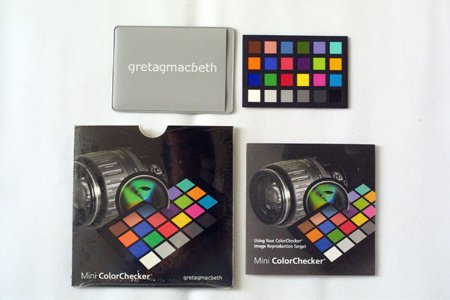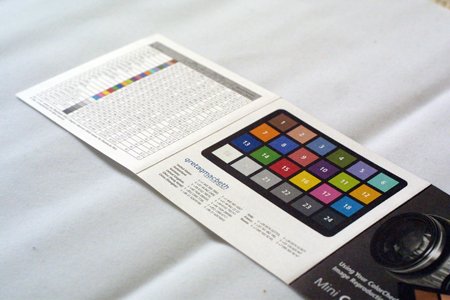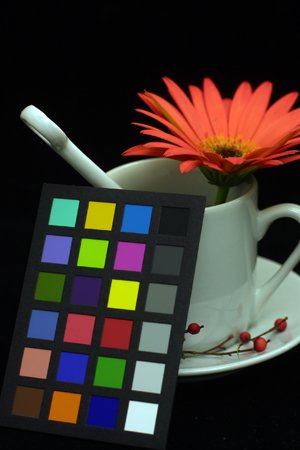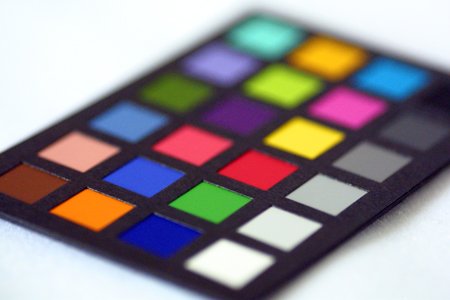GretagMacbeth ColorChecker Charts
GretagMacbeth provides technology, based on Munsell color standards, to calibrate your reproduction equipment, such as cameras, scanner, monitors, etc., for precise color correctness. One series of its products is its ColorChecker charts, including: ColorChecker, Mini ColorChecker, Digital ColorChecker SG, ColorChecker White Balance, and ColorChecker Gray Scale. I have the entire series of charts and this article reviews their charts.
Mini ColorChecker
I received the GretagMacbeth Mini ColorChecker today. It came in a box filled with foam peanuts to prevent damage. The content of the package was a shrink-wrapped CD cardboard case with a nice design. The graphic design is a composite image of the Mini ColorChecker, a lens, and a SLR camera. It looked professional. And the cover art is especially appealing to me, because having used the Canon EOS system for years, it's obvious to me that the camera and lens is from the Canon EOS line-up. The cover art aside, slitting the shrink-wrap open reveals the content, an instruction manual, a soft pouch, and the Mini ColorChecker (see picture below).

Surprisingly, the instruction sheet is rather simple. It's a single sheet with two folds. It feels more like a pamphlet or brochure rather than a manual. But with one glance, you'd realize its importance. Contained in its six surface sections are the cover art, "Before you begin using the ClorChecker Image Reproduction Target", "Steps for using the chart", "Some signs of color balance issues, the color patch identifications, and the correct color values of each patch. The color patch identifications and values (see picture below) are extremely important and is the key to matching the color in your reproduction workflow. The other three instructional sections are extremely brief and to the point. For an experienced professional, the instructions serve as a good reminder for the process. But for a beginner, it's no way to start.

It's obvious that GretagMacbeth intended to continue the education on its web sites, because it had mentioned both of them at the end of the instruction sheet. I found a brief walkthrough of using the ColorChecker here. If you like to download the training video so that you can view it on your computer even without Internet connection, you can get videos for the PC and the Mac here. The PC version of the interactive training video is about 20 megabytes. The interactive video is a good walkthrough and enough to start using your ColorChecker. But not detailed enough to use the ColorChecker's full potential.
The Mini ColorChecker is smaller enough to fit into any scene. I find it really handy for macro shots and where the subject is rather small. In those shots, you are generally using 50mm to 100mm lens. It would be difficult to fit a full-size ColorChecker in your camera frame. The Mini ColorChecker, on the other hand, fits perfectly (see picture below). However, if you are shooting fashion, such as swimsuit on a full-portrait model, the tiny Mini ColorChecker wouldn't be big enough to cover the representative portion of your frame.

The soft pouch is a nice touch for protecting the 3-1/4"x2-1/4" Mini ColorChecker. It is gray with "gretagmacbeth" imprinted on it in white. The credit card-sized Mini ColorChecker slides in and out smoothly without being too loose. You can actually hold the pouch with the opening downwards and there is no chance of the Mini ColorChecker falling out (as long as you don't shake it). But don't think of the porch as an invitation to carry the credit card-sized Mini ColorChecker in your pants pocket or your wallet. The Mini ColorChecker is a precision instrument, any bent or crease will reduce its ability to provide the correct color reference.
The Mini ColorChecker itself is made out of paper and cardboard; high quality paper and cardboard, that is. It's made out of three layers. The backing is a thick black cardboard to keep the Mini ColorChecker stiff. The middle layer is the actual color palette standard printed on a sheet of paper. The top layer is a thin, but heavy duty, cardboard with window cut-outs for each color in the palette (see photo below). The top two layers of the Mini ColorChecker have a flat, matte surface to prevent reflective glare that could throw off your color balance calibration.

The Mini ColorChecker has a "checkerboard array of 24 scientifically prepared colored squares". The color squares represent color in nature, such as human skin, foliage, and blue sky. The squares also reflect light in the same way as their natural counterpart, thus it matches color under any illumination and with any color reproduction process. GretagMacbeth lists the following applications for the ColorChecker.
- Photography: Check films, lights, filters, and paper.
- Graphic Arts: Check any printing or proofing process.
- Electronic Publishing: Check scanners, monitors, and proofing devices.
- Television: Check cameras, monitors, lights, and film.
Although not listed as one of its applications, I think for a digital photographer, the ColorChecker is a great tool for adjusting the color correctness of your digital photograph. In the future, I will attempt the process and show you how to accomplish that task on this web site.
The Mini ColorChecker is well-made and aesthetically pleasing. The color array looks like an artist's palette or a woman's make-up powder. My wife kept looking over my shoulders, wanting to hold and play with the Mini ColorChecker. Due to its visual appeal, if I haven't told my wife that this is a precision photographic instrument, which I need, the Mini ColorChecker would probably end up in her make-up treasure chest when my back is turned.
RelatedLinks
- Color Temperature and Color Correction in Photography
- GretagMacbeth
- Gretag Macbeth ColorChecker Chart, 8.5" x 11.5" - Amazon User Reviews
- Gretag Macbeth Digital ColorChecker SG (Semi-Gloss), 8-1/2" x 11" Card for use with ProfileMaker 5 Digital Camera Module. - Amazon User Reviews
- Gretag Macbeth Mini ColorChecker Chart 3.5" x 2.5" - Amazon User Reviews
$10000-above
$5000-$9999
$2000-$4999
$1000-$1999
$500-$999
$200-$499
$100-$199
$50-$99
$25-$49
$0-$24
Gift Certificate

